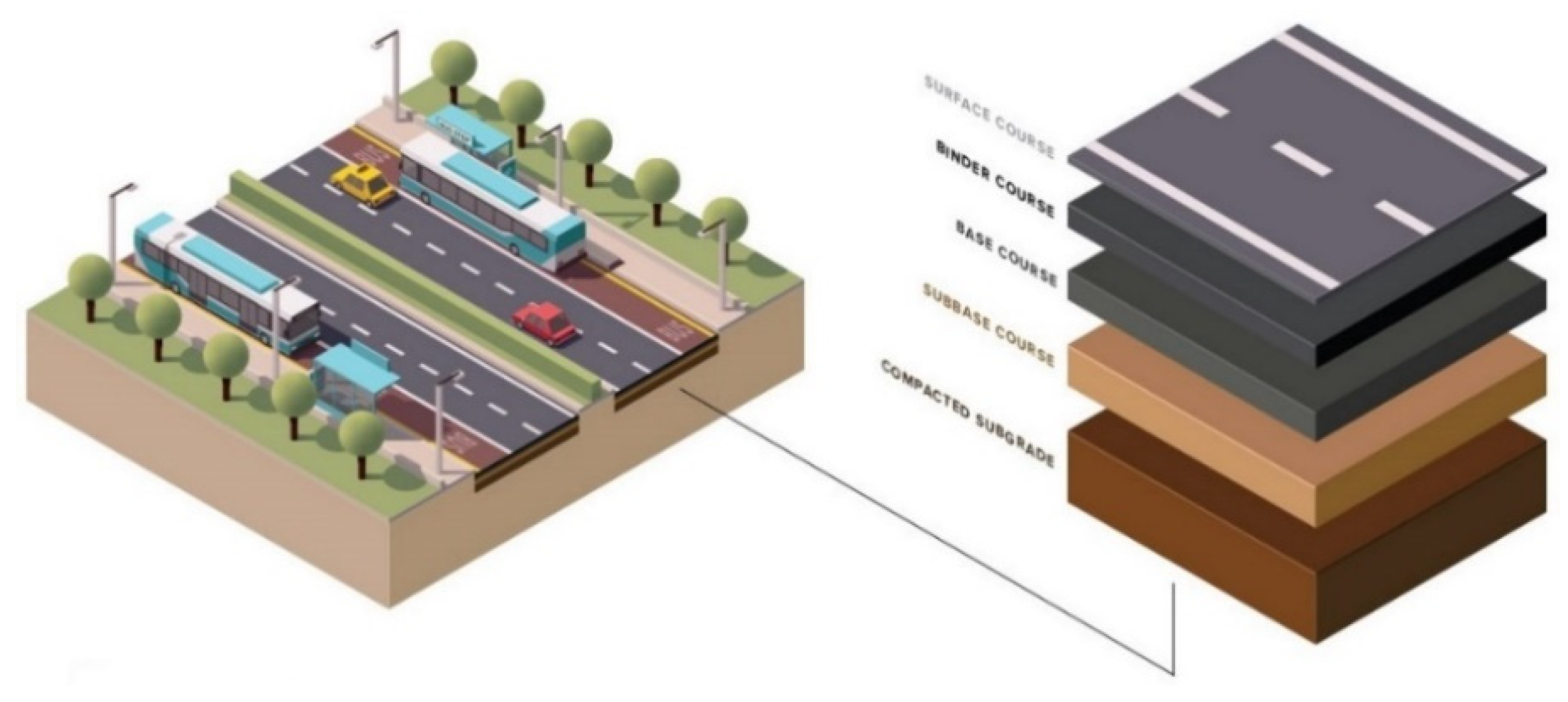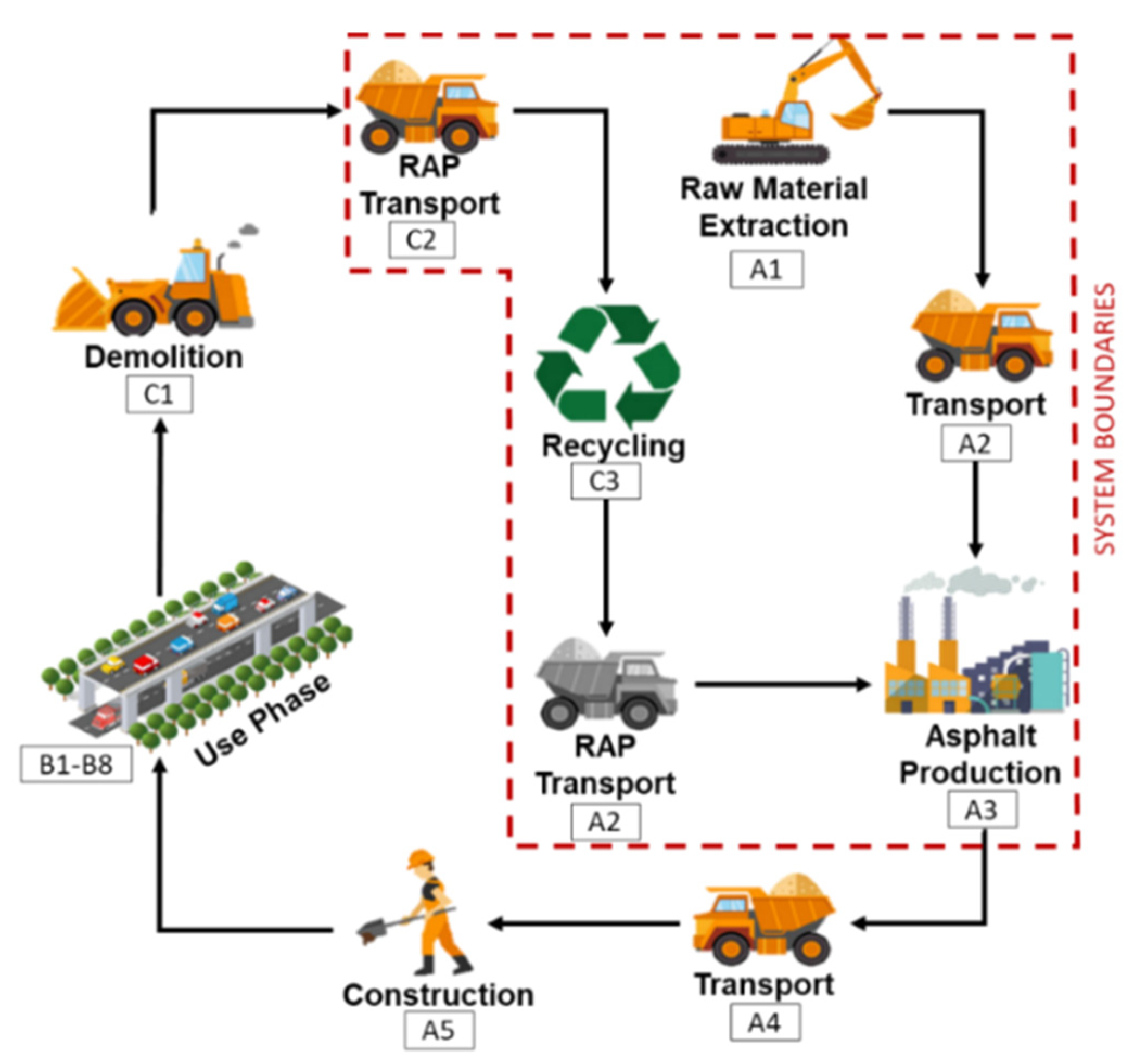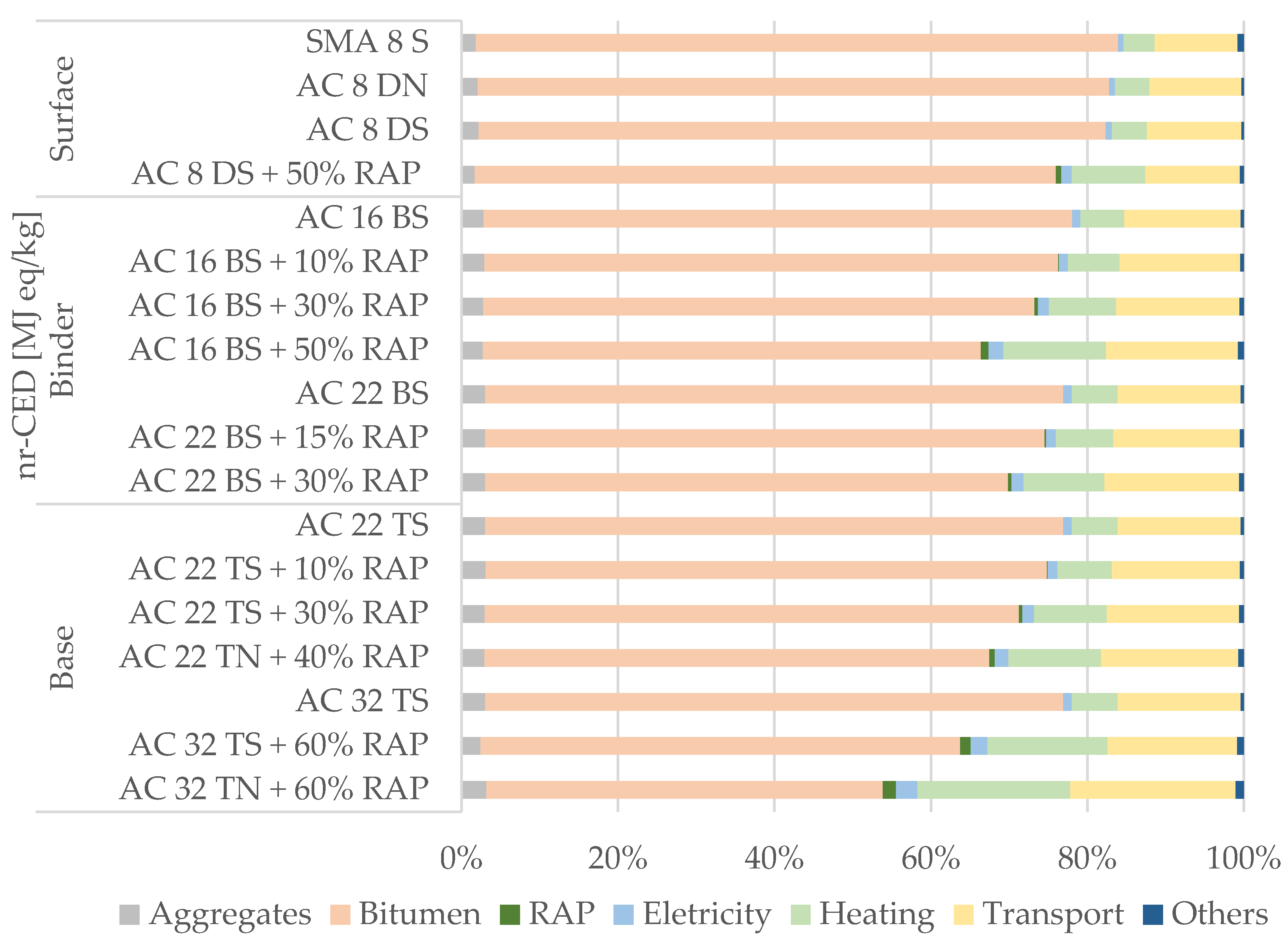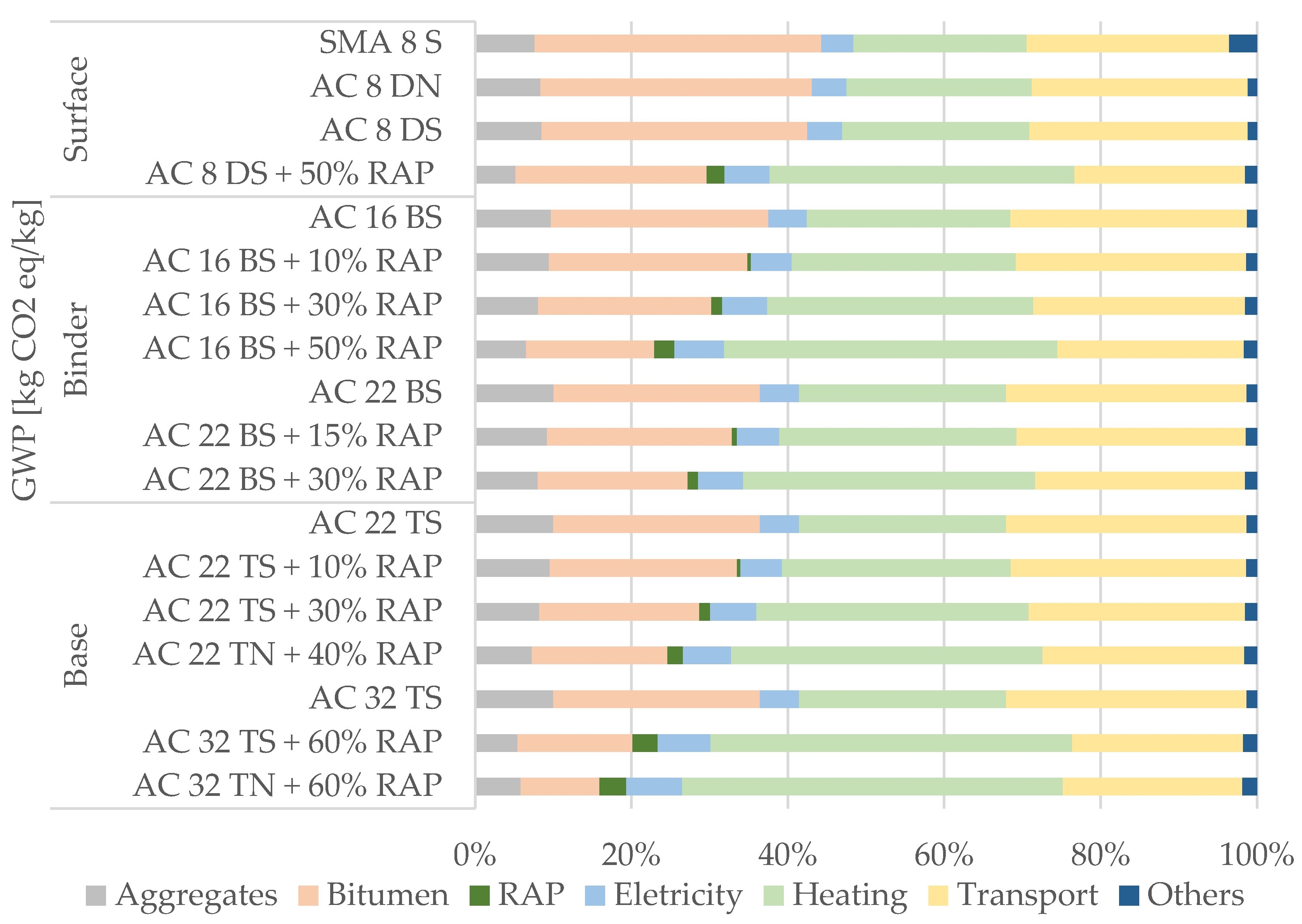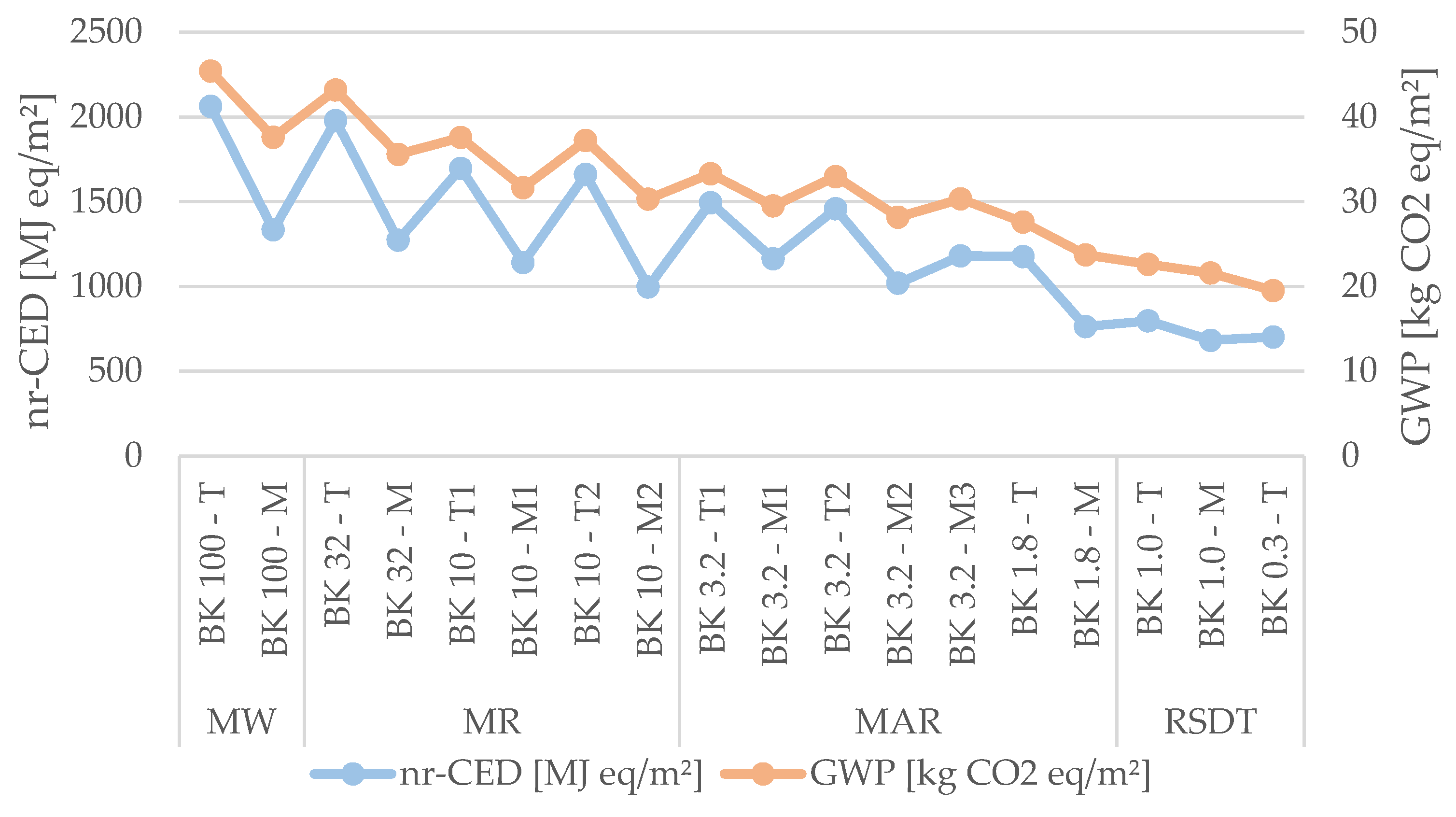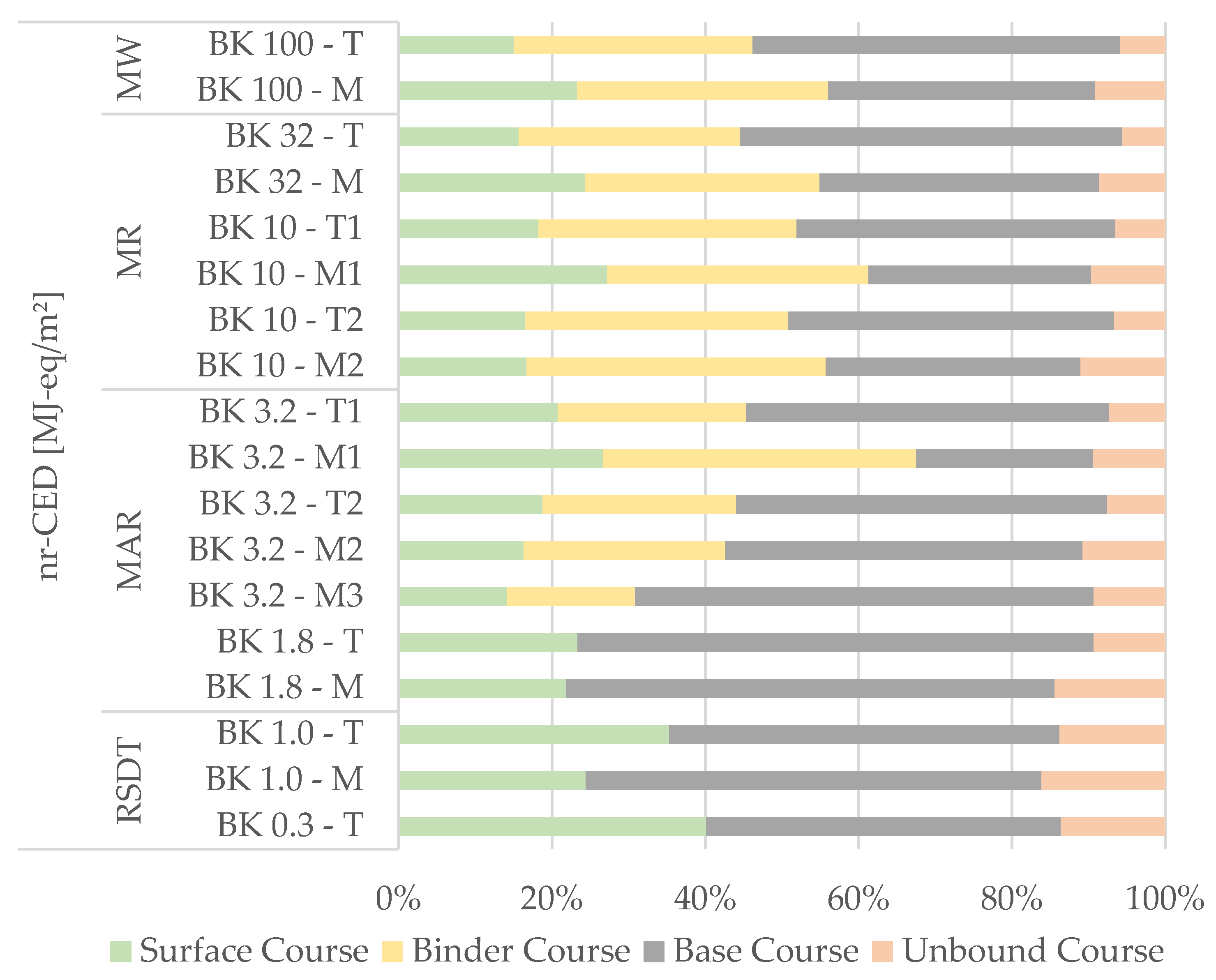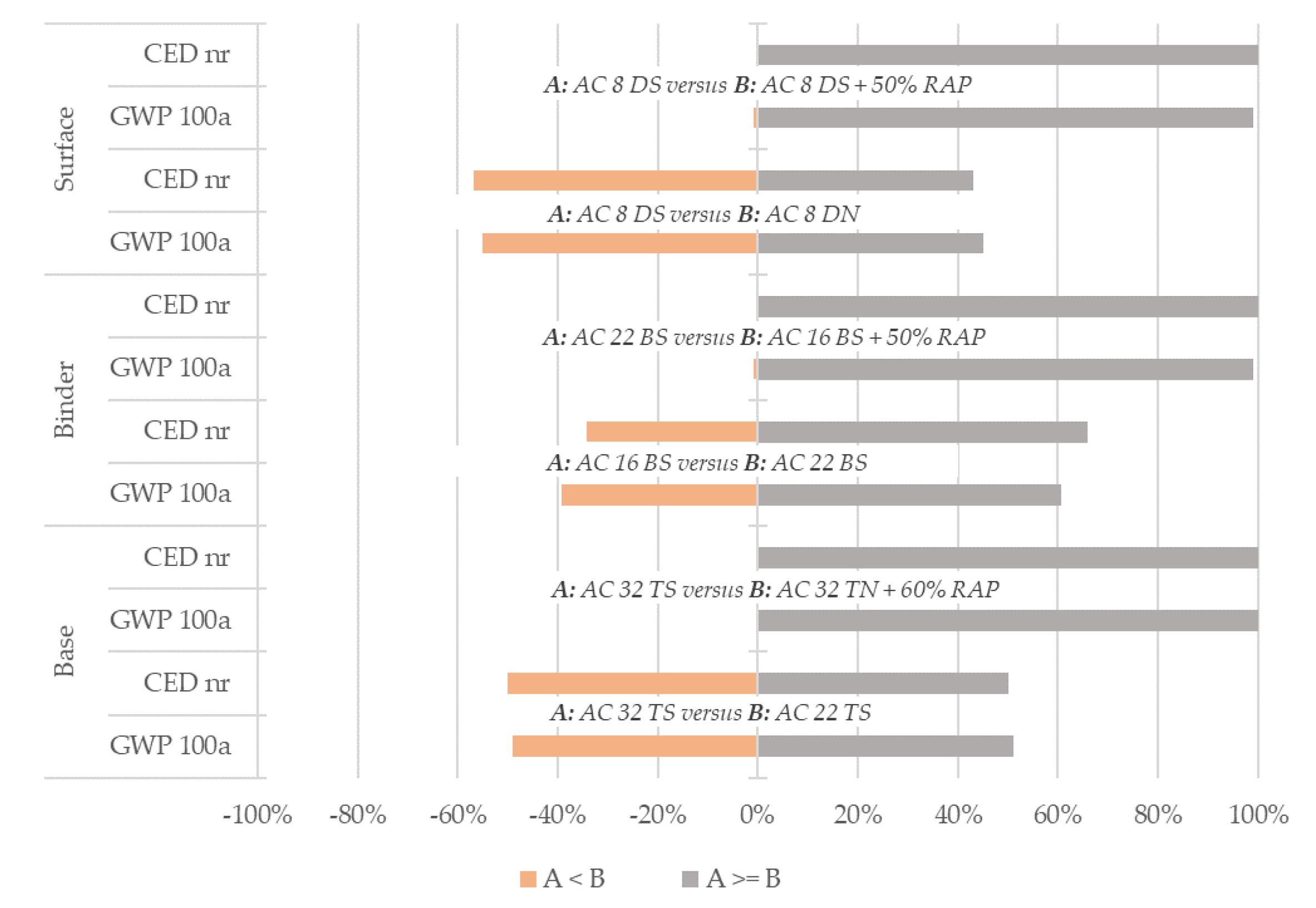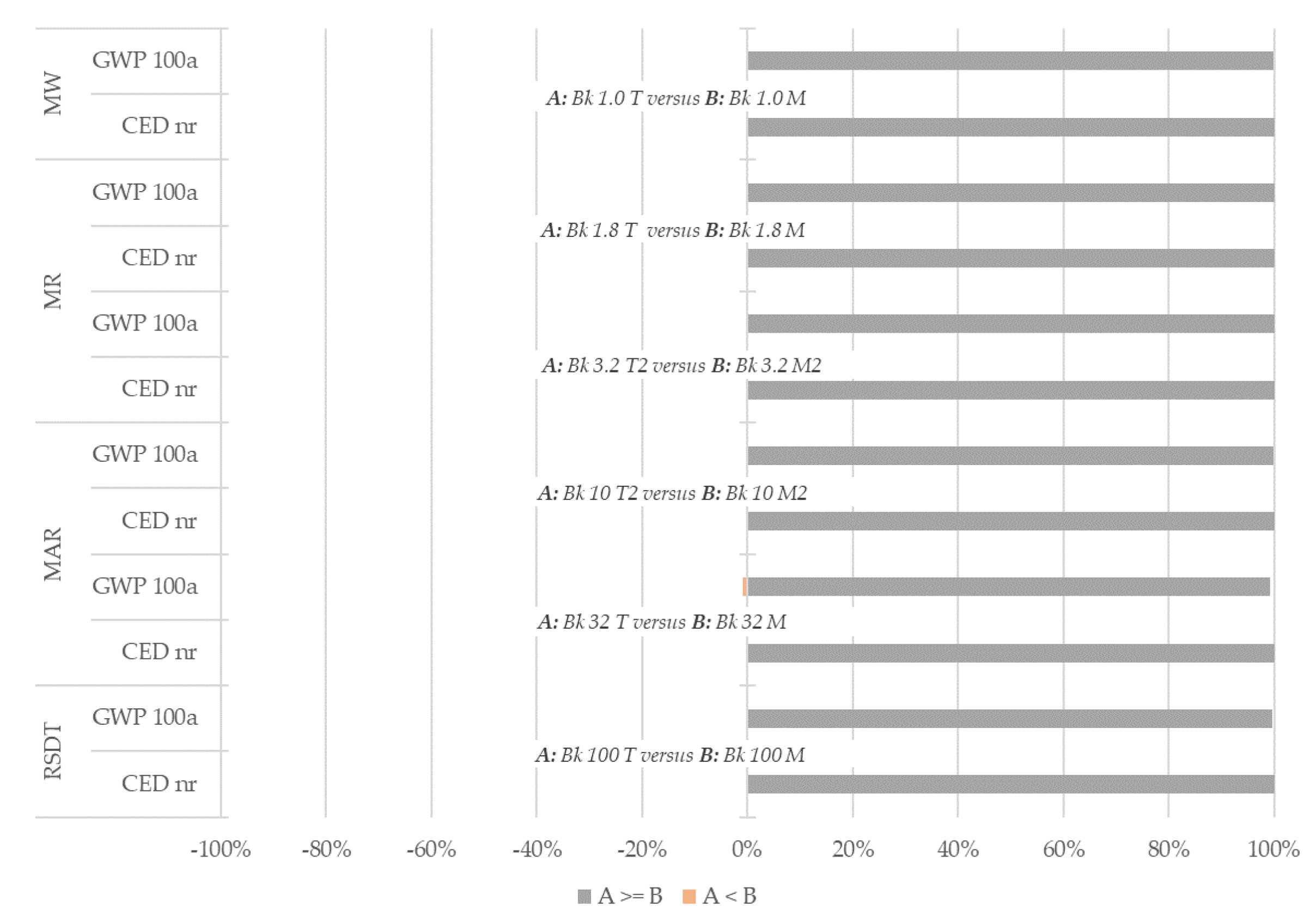1. Introduction
In 2015, the United Nations (UN) established a plan of action to improve the prosperity of society. Titled Agenda 2030, this plan of action comprises 17 Sustainable Development Goals (SDGs), which are political goals to ensure sustainable development on economic, social, and environmental levels, addressing global challenges related to poverty, inequality, climate, environmental degradation, and prosperity, as well as peace and justice. A sustainably built environment is one of the prerequisites for the realization of the SDGs by 2030, wherein sustainable transport infrastructures and systems form a core part of a future-oriented built environment. This is demonstrated in the detailed targets and specifications in the SDGs. For example, SDG 11—“Sustainable Cities and Communities” specifies “access to safe, affordable, accessible and sustainable transport systems for all” as a relevant SDG target [
1]. Urban road systems, with their network density and high traffic loads, need to contribute to urban transport systems within the UN SDGs.
Despite the constant efforts to reduce the carbon footprint and make road constructions more sustainable, road pavements still have a large contribution to environmental impacts within the construction industry. In the UK, for example, roads consume around 25% of all materials extracted from the ground [
2,
3] making them a significant target to improve sustainability.
It is a common sense that primary raw materials used to build pavements are scarce and the world urgently requires a solution. The environmental impacts of using primary raw materials to compose pavements occur not only due to the extraction process but also due to the transportation since they are normally transported across long distances. On the other hand, the use of recycled materials reduces the impacts of extraction and is more likely always available, which mitigates the impacts of transportation.
The benefits of using recycled materials to compose asphalt mixtures are not only environmental but also economical. The use of RAP is more cost-effective than using primary raw materials [
4]. In terms of mechanical performance, studies have shown that asphalt mixtures with RAP perform equally to regular ones [
5,
6,
7].
Nevertheless, increasing the amount of RAP as the raw material used to compose asphalt mixtures is still a challenge since authorities must be convinced and regulations need to be changed.
Over the past years, a variety of studies have been conducted, analyzing the environmental sustainability of road infrastructure and specifically of road pavements by applying the life cycle assessment (LCA) methodology [
8,
9,
10,
11,
12,
13,
14,
15,
16,
17,
18,
19,
20]. Most of these studies evaluated the environmental impacts of road pavements using a holistic approach over their entire life cycle or rather over a specific analysis period [
10,
11,
12,
14,
18,
21]. Some of these studies focused specifically on the environmental influence of maintenance strategies and policies [
10,
11,
12,
14,
20].
An example of a holistic sustainability study of urban road infrastructure was conducted by Trigaux et al. [
18], who assessed the environmental and economic impacts of roads in residential neighborhoods considering their whole life cycle (material production, pavement construction, maintenance and replacement, usage by traffic, demolition, and end of life), including supply infrastructure such as electricity supply and pipework. Gschösser [
20,
21] analyzed asphalt and cement concrete pavements for highways and main roads over their entire life cycle, focusing on the environmental and economic impacts of construction and maintenance processes, including material production. Both studies demonstrated the strong influence of material production processes on the overall environmental results, underlining the need to perform specific studies analyzing environmental potential within the production processes of road materials, as shown in various studies [
13,
16,
17,
18,
19].
To reduce the environmental impacts of road material production, the main focus is the application of alternative raw materials and enhanced production processes. In this context, Gschösser [
13], for example, assessed the potential reduction of environmental impacts within asphalt production processes with lower mixing temperatures due to the lower moisture contents of the applied aggregates and the application of foam bitumen. The partial substitution of primary raw materials (bitumen and mineral aggregates) with reclaimed asphalt pavement (RAP) and the connected environmental influence was analyzed. Farina et al. [
19] performed an LCA, analyzing different types of asphalt mixtures containing recycled materials, such as crumb rubber from scrap tires, and RAP, comparing the results with standard paving materials. The literature review by Balaguera et al. [
15] reported RAP, fly ash, and polymer as the most frequently applied alternative raw materials used within asphalt materials [
16,
17]. Balaguera et al. showed that most of the material studies focused on road materials for pavements with high traffic loads (e.g., highway pavements) and that the most frequently analyzed environmental indicators for road material LCA are non-renewable cumulative energy demand (nr-CED) and global warming potential (GWP).
The results of the analyzed LCA studies showed that the environmental performance of asphalt materials depends on numerous factors, being strongly influenced by local conditions. The City of Münster (Germany) is embracing Agenda 2030 into its strategic policies and aspires to enhance the environmental performance of its urban road network within the next few years. Therefore, the Department of Mobility and Civil Engineering of the City of Münster (Germany), together with the Münster University of Applied Sciences joined the Horizon2020 research project SAFERUP! (Sustainable, Accessible, Safe, Resilient and Smart Urban Pavements, funded by the European Union), wherein a specific environmental analysis for road pavements and materials applied within the urban road network of Münster was performed in cooperation with the University of Innsbruck (Austria). The first part of this research cooperation focused on the environmental potential within the production of road materials applied to the Münster road network.
The road network in Münster is exclusively formed of asphalt pavement. Based on the experience of the Department of Mobility and Civil Engineering of the City of Münster, we used the case study presented in this paper to examine alternative asphalt production scenarios based on the application of RAP as a raw material. The performed LCA study was based on test series and production data from a representative asphalt plant in the Münster region (one of the main asphalt suppliers of the City of Münster). The plant already produces particular asphalt mixtures containing RAP but has been encouraged (mainly by the City of Münster) to intensify the application of RAP, and to further enhance its production process from an environmental point of view. The potentials for the alternative production scenarios were determined on the pavement level, i.e., for the complete pavement structure with all its different layers and different asphalt types. Thereby, all pavement types applied in the road network in the City of Münster were analyzed.
4. Results
4.1. Asphalt Materials Results
Table 6 and
Figure 4 show the environmental impacts (GWP—Global Warming Potential and Nr-CED—Non-renewable Cumulative Energy Demand) associated with the production of the asphalt mixtures analyzed.
In general,
Figure 4 shows that the production of asphalt mixtures to be applied in the surface layers has a greater environmental impact than the asphalt materials used in binder and base layers because the bitumen is responsible for a large share of gas emissions and the more bitumen in the asphalt mixture, the greater the environmental impact.
Considering the asphalt materials without RAP, the production of AC 8 DS and AC 22 BS produced fewer environmental impacts amongst the options used for surface and binder layers. For the base layers, both asphalt materials AC 22 TS and AC 32 TS generated the same impact regarding nr-CED and GWP indicators.
Despite the greater amount of energy required by asphalt materials with RAP, due to the heating strategy used in the asphalt plant, the more RAP included, the lower the environmental burden associated with the production of asphalt mixtures per both GWP and nr-CED indicators. This occurs because the more RAP used, the fewer raw materials (e.g., aggregates and bitumen) and processes are required to produce the asphalt mixtures.
The use of higher RAP contents potentially reduces nr-CED by 47% and GWP by 25% for surface and binder layers, and approximately 61% nr-CED and 30% GWP for the base layers.
The comparison of asphalt mixtures applied to binder layers with the same amount of RAP, such as AC 16 BS and AC 22 BS with 30% RAP or within base layers, e.g., AC 32 TS and AC 32 TN with 60% RAP, indicated similar impacts concerning GWP. For nr-CED, however, the production of AC 22 BS with 30% RAP instead of AC 16 BS with 30% RAP potentially reduces the impact by 8.6%, whereas the production of AC 32 TN with 60% RAP instead of AC 32 TS with 60% RAP lowers the environmental burden by 22%.
In
Figure 5, the environmental loads per nr-CED results are divided into different categories, considering the impacts of raw materials and processes caused by the mixtures during asphalt production.
As shown in
Figure 5, the bitumen is mainly responsible for the environmental burden associated with the production of asphalt mixtures due to the energy and resources required for its extraction and manufacturing processes.
Asphalt mixtures with RAP require less bitumen, which automatically reduces the impact attributed to the bitumen in terms of nr-CED. However, increasing the RAP content increases the amount of heating energy required, due to the cold recycling method applied by the asphalt producer.
Transportation was the category second most affecting the nr-CED results. The higher the amount of bitumen and aggregates, the higher the transportation impact due to the distances the raw materials must be transported to the asphalt plant. As the RAP is sourced from the demolition of Münster roads, the distance for its transportation has little influence on nr-CED.
Figure 6 shows the impacts of asphalt production in terms of GWP.
Figure 5 and
Figure 6 show that the use of RAP, aggregates extraction, and electricity have the least influence on the entire environmental impact caused by the production of asphalt materials.
Heating is responsible for a greater share of the impact for asphalt materials composed of higher percentages of RAP. For example, heating is responsible for approximately 50% of all impact generated by the production of AC 32 TS with 60% RAP and AC 32 TN with 60% RAP in terms of GWP.
In general, transportation is responsible for approximately 20% of the GWP. Bitumen and heating are responsible for 15%–30% of impact depending on the amount of RAP and bitumen used to produce the asphalt materials. Therefore, the higher the RAP content, the higher the heating and the lower the bitumen. The higher the bitumen content, the less heating required.
4.2. Pavement Structure Results
Table 7 shows the nr-CED and GWP results attributed to the traditional and modified structures.
Figure 7 depicts the data in a chart.
Figure 7 shows that the higher the traffic load designed for the road, the greater the environmental burden associated with the pavement structure. Therefore, the production of asphalt mixtures used to compose Bk 100 structures potentially have a greater impact than Bk 32, and Bk 32 should have greater impacts than Bk 10. In general, the asphalt materials used for traditional motorway structures have a 66% greater impact in terms of nr-CED than Bk 0.3 structures and around 57% more in terms of GWP due to the greater amount and quality of raw materials demanded.
The traditional structures have more of an environmental impact compared with the modified alternative. The production of asphalt materials to create modified structures instead of traditional ones can lower the nr-CED up to 42% and 19% in terms of GWP.
The environmental burden associated with the Bk 100-M is 35% lower in nr-CED and 17% lower in GWP compared with Bk 100-T. The Bk 100-M structure potentially has less of an impact than Bk 32-T and almost the same impact as Bk 32-M. Hence, even with the higher amount of road materials required to compose motorway roads, the results demonstrated that the process of choosing less impactful road materials to construct each layer can considerably decrease the overall impact associated with road pavement construction.
In the MR category, the pavement structure Bk 10-M2 had the least impact. In the MAR category, Bk 3.2-M2 produced less impact than the other options for both indicators. The alternative Bk 3.2 structures (i.e., M1 and M2) performed slightly better than the structure tested by Münster (i.e., Bk 3.2-M3), decreasing the nr-CED by 31% and GWP by 15% compared with the traditional option (i.e., Bk 3.2-T1), whereas Bk 3.2-M3 reduced the impacts per nr-CED by 21% and per GWP by 9%.
Figure 8 and
Figure 9 show the environmental burdens associated with each layer in terms of nr-CED and GWP indicators. Despite the higher thickness, the unbound layer produced less of an impact of production within all asphalt materials. As observed in
Figure 5, the nr-CED results were highly influenced by bitumen. Therefore, due to the lack of bitumen, the unbound layer had a minor contribution to the impact results.
In general, the base layer had major environmental impacts due to its thickness and raw materials used. The greater the thickness, the higher amount of raw materials and the higher the amount of bitumen, which is the road material that affects nr-CED values the most. The asphalt material modelled for base layers has a lower RAP content in comparison with the surface and binder layers, which also influenced the results since the environmental burden attributed to the surface and binder layers is directly related to the amount of RAP used to compose the asphalt mixtures.
As shown in
Figure 6, transportation has a considerable influence on the impacts caused by the production process. Thus, most of the impact of the unbound layer in
Figure 9 is due to its composition of 100% aggregates, sourced from outside Münster.
The impact caused by the different layers in terms of GWP (
Figure 9) depends on the amount of RAP and bitumen used to produce asphalt materials. As heating considerably influenced the GWP results, the layers designed with asphalt materials and RAP are responsible for a larger share of the environmental influence than in the nr-CED results.
4.3. Monte Carlo Analysis
Figure 10 shows the probability that the environmental impacts of the traditional asphalt mixtures is higher or lower compared to asphalt mixtures with the highest content of RAP.
Figure 10 also provides a comparison with asphalt materials without RAP.
According to
Figure 10, the asphalt materials containing higher amounts of RAP have lower environmental impacts than the traditional materials. The comparison between traditional asphalt materials applied to surface and base layers showed similar performances. The AC 22 BS used within binder layers performed slightly better than AC 16 BS.
Figure 11 shows the Monte Carlo simulations applied to traditional and modified structures that potentially perform better for each group of traffic load. The results showed that pavement structures containing asphalt materials with higher amounts of RAP have a higher probability of producing less of an impact on the environment than the traditional structures used within Münster pavements.
5. Conclusions and Future Works
In this study, we analyzed the environmental impacts associated with the production of asphalt mixtures applied to urban pavements in Münster and identified the benefits of using recycled materials, such as reducing the carbon footprint of road pavement constructions.
The results show that, despite the high amount of heating energy required due to the cold recycling method applied by the Munster asphalt plant, that increasing the amount of RAP reduces the environmental impacts during the production of asphalt mixtures.
The use of larger amounts of recycled raw material to compose the asphalt mixtures does not only reduce the impacts of primary raw material extraction but also the impacts caused by transportation. The transportation distances were reduced from an average of 160 km to 25 km. If we consider the average of CO
2-emission recommended by McKinnon [
39,
40] for road transport operations (62 g CO
2/tonne-km), the use of RAP to produce asphalt mixtures can lower the emissions by up to 217.62 kg CO
2/tonne-km.
The results additionally indicated that asphalt mixtures without RAP applied to surface (i.e., AC 8 DS and AC 8 DN) and base layers (i.e., AC 22 TS and AC 32 TS) perform similarly. Within the binder layer, the AC 22 BS has lower environmental burdens than AC 16 BS.
In general, the pavement structures designed to support lower traffic loads have minor environmental impacts due to the reduced demand for raw materials. The structures with reduced environmental impact potential are the combination of asphalt materials with the highest amount of RAP as possible. For main access roads, the structure Bk 3.2-M2 produces a lower environmental burden than the other Bk 3.2 structures; for main roads, Bk 10-M2 has a higher environmental impact.
The data used in this paper represent the reality in Münster and may not be applicable to other situations. The modified structures suggested in this study include asphalt materials that potentially have lower environmental impacts and may not be suitable for real application since local regulations must be considered in pavement design. Nevertheless, the findings provide guidance on how to apply life cycle assessment to evaluate the environmental impacts of asphalt production and can provide the basis for comparison with similar cases.
Despite all benefits presented, to calculate the total advantages of using RAP, it is necessary to evaluate the lifetime of pavements composed with asphalt mixtures with a higher content of RAP and include this variable in a future ‘cradle-to-grave’ analysis.
In this study, we only considered the production phase to evaluate the environment impacts of the asphalt mixtures. Therefore, to fully evaluate the sustainability of the road network in Münster, we intend to perform a cradle-to-grave and cradle-to-cradle analysis and include construction, maintenance, demolition, and end of life phases in future works.
